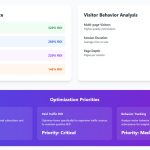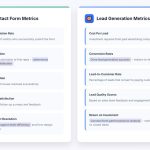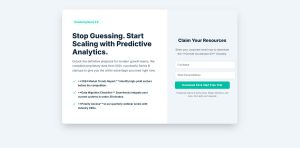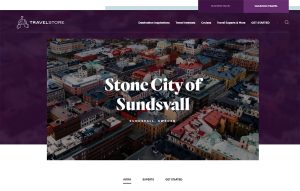Your website probably loses more subscribers than it gains. That’s the reality when your email signup sits ignored in the footer or buried on a contact page somewhere. Opt-in form…
Table of Contents
Every second, potential customers decide whether to share their contact information or click away forever. How to design lead capture forms that convert requires understanding user psychology, technical implementation, and strategic optimization techniques.
Poor form design costs businesses thousands of qualified prospects monthly. The average website form converts only 2-3% of visitors, while optimized forms achieve 20%+ conversion rates.
This guide reveals proven strategies for creating high-converting forms that transform casual visitors into qualified leads. You’ll discover:
- Core design principles that drive completion rates
- Technical implementation best practices for seamless user experience
- Strategic placement and timing tactics
- Copywriting techniques that communicate value effectively
- Advanced optimization methods using A/B testing and personalization
- Common mistakes that kill conversions
Master these form optimization fundamentals to boost lead generation and accelerate business growth.
Core Design Principles for High-Converting Forms
Form Length and Field Selection Strategy

The relationship between form length and conversion rates creates a direct impact on your lead generation success. Shorter forms typically convert better, but the quality of leads may suffer.
Longer forms filter out casual browsers while attracting serious prospects.
The average number of form fields is 5, and two-thirds of people who start filling out a form successfully complete it. However, this completion rate drops when forms become too lengthy.
Most successful landing page forms contain between 3-5 fields. Beyond this threshold, conversion rates drop significantly. For each additional field you add, your conversion rate may drop anywhere from eight to 50 percent.
Essential Field Selection
Identifying truly necessary information fields requires strategic thinking about your customer acquisition funnel. Start with these essential elements:
- Name (first name only works better than full name)
- Email address
- Phone number (only if immediate contact is critical)
- Company name (for B2B lead qualification)
One study found that by making a phone number optional, it nearly doubled conversion rates, and cut fallout from 39 percent to four percent.
Progressive Profiling Benefits
Progressive profiling techniques help capture additional data over time. Instead of overwhelming visitors with lengthy forms, collect basic information first.
Then gather more details through follow-up interactions and subsequent form submissions.
Single vs Multi-Field Approaches
When to use single-field forms depends on your conversion goals. Email capture forms work exceptionally well with just one field. Multi-field approaches suit lead qualification better, helping you identify high-value prospects immediately.
Only 40% of marketers use multi-step forms but their conversion rate is 86% higher. This approach allows you to collect more information without overwhelming users.
Visual Design Elements That Drive Completion
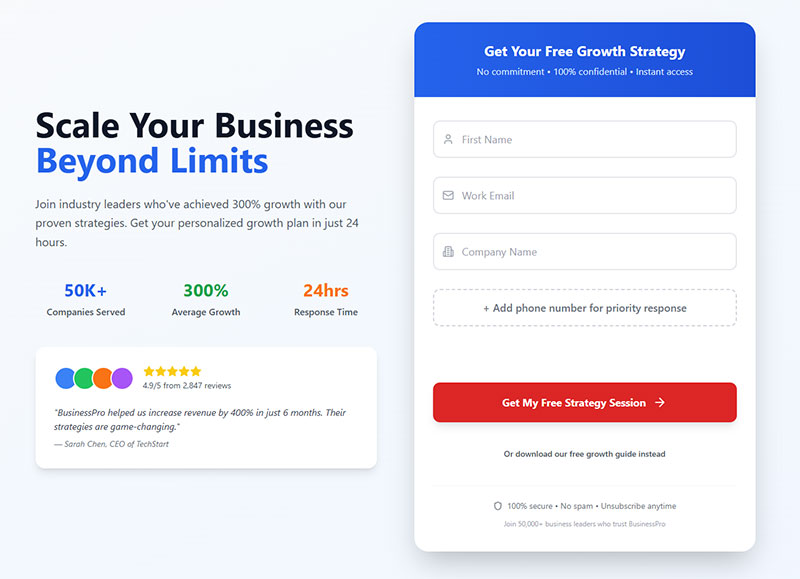
Color psychology plays a crucial role in form conversion optimization. Research shows specific colors trigger different responses from users.
Button Color Psychology
Studies of top shopping websites found around 20% used red CTA buttons, 19% green, 18% blue and 17% orange. Each color serves different purposes:
- Red buttons create urgency and encourage immediate action
- Blue conveys trust and reliability, perfect for professional services
- Green suggests positive outcomes and works well for signup processes
- Orange represents energy and enthusiasm
HubSpot found a red button resulted in 21% more clicks than green, though results vary by audience and context.
White Space Impact
White space usage dramatically improves user experience and form completion rates. Crowded forms overwhelm visitors and increase abandonment rates.
CTA buttons surrounded by more white space can increase conversion rates by over 200%.
Proper spacing between fields makes forms appear simpler and more approachable.
Typography Considerations
Typography choices directly affect readability and user engagement. Sans-serif fonts like Arial or Helvetica work best for digital forms.
Font sizes below 14px create accessibility issues and frustrate mobile users.
Strategic Button Placement
Button design and placement can boost conversions by 20-30%. Primary buttons should stand out with contrasting colors. Secondary buttons need subtle styling to avoid competing with main calls-to-action.
Place buttons prominently without requiring users to scroll.
Creating Clear and Compelling Form Headlines
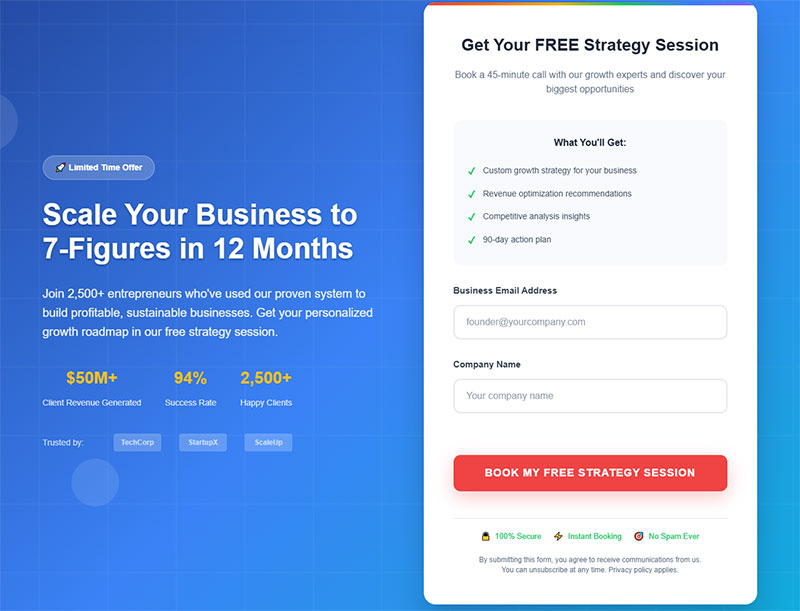
Effective headlines communicate value instantly. “Get Your Free Marketing Guide” outperforms “Subscribe to Newsletter” because it specifies the benefit.
Value-focused messaging increases conversion rates significantly.
Urgency and Scarcity Tactics
Using urgency and scarcity in form messaging creates psychological triggers that drive action. Examples include:
- “Limited Time Offer”
- “Join 500+ Marketing Professionals”
- “Only 24 hours left”
These tactics work by using social proof and time sensitivity. However, avoid overusing these approaches as they can appear manipulative.
Audience-Specific Messaging
Matching headline tone to your target audience helps create better connections. B2B audiences respond to professional, benefit-focused language.
Consumer audiences prefer conversational, emotion-driven messaging.
Copy written at a 5th to 7th grade level converts at 11.1% compared to professional-level writing which converts at 5.3%.
Testing for Optimization
Testing different headline approaches reveals what resonates with your specific audience. A/B testing headlines often produces surprising results that challenge assumptions about user preferences.
Companies that A/B test their forms report conversion rates that are 10% higher on average than those who don’t use split tests.
Consider testing variations of:
- Benefit statements vs feature descriptions
- Question format vs statement format
- Personal vs business language
- Short vs detailed headlines
Technical Implementation and User Experience
Mobile Optimization Requirements
Responsive design considerations for forms go beyond simple scaling. Mobile users behave differently than desktop users, requiring specialized approaches to form design and functionality.
Touch-friendly input fields need minimum 44px height to accommodate finger taps accurately. Buttons require adequate spacing to prevent accidental clicks. Mobile forms with cramped layouts frustrate users and increase abandonment rates.
Mobile-specific form layouts should stack fields vertically rather than side-by-side. Single-column layouts work better on small screens. Minimize scrolling by keeping forms concise and prioritizing essential fields only.
Testing forms across different devices reveals platform-specific issues. iPhone users may experience different rendering than Android users. iPad layouts differ from smartphone presentations, requiring comprehensive testing protocols.
Form Field Types and Input Methods
Choosing between dropdown menus and radio buttons depends on the number of options and user experience goals. Dropdown menus save space but hide options from immediate view. Radio buttons display all choices upfront but require more screen real estate.
Use dropdowns for:
- Lists with 5+ options
- Country/state selections
- Product categories
Use radio buttons for:
- 2-4 options maximum
- Yes/no questions
- Priority selections
Text field optimization varies by data type. Email fields should include proper validation and helpful error messages. Phone number fields benefit from formatting assistance and country code detection.
Date picker and calendar integration improves user experience for event registration and appointment scheduling. WordPress event registration form examples demonstrate effective date selection implementation.
File upload capabilities expand form functionality when collecting resumes, portfolios, or supporting documents. However, file uploads significantly increase form complexity and loading times.
Error Handling and Validation Techniques
Real-time validation provides immediate feedback as users complete fields. This approach prevents frustration and reduces form abandonment. Post-submission validation forces users to review and correct multiple errors simultaneously.
Implementing form validation requires balancing user experience with data accuracy. Validate email formats, required fields, and character limits without creating obstacles.
Clear error message writing guides users toward successful completion. Avoid technical jargon and provide specific correction instructions. “Please enter a valid email address” works better than “Invalid input detected.”
Field highlighting and correction guidance help users identify and fix problems quickly. Red borders or background colors draw attention to problematic fields. Green indicators confirm successful completion.
Common user input mistakes include:
- Incorrect email formats
- Missing required fields
- Password strength requirements
- Phone number formatting issues
Preventing these mistakes through proactive design reduces user frustration and improves conversion rates. Smart defaults, formatting assistance, and clear instructions minimize errors before they occur.
Best practices for technical implementation:
- Use HTML5 input types for better mobile keyboards
- Implement proper tab order for keyboard navigation
- Include ARIA labels for screen reader accessibility
- Test with form accessibility guidelines
- Ensure GDPR compliant forms meet privacy requirements
Technical excellence in form implementation creates seamless user experiences that convert visitors into qualified leads. Focus on removing friction while maintaining data quality and security standards.
Strategic Placement and Timing
Website Placement Strategies
Above-the-fold positioning captures immediate attention but risks appearing too aggressive. Below-the-fold placement allows users to consume content before encountering forms, building trust and context first. The sweet spot often lies between these extremes.
Sidebar forms provide consistent visibility without interrupting content flow. They work exceptionally well for blogs and resource pages where visitors demonstrate engagement through scrolling behavior. Contact us page implementations show how strategic sidebar placement increases visibility.
Landing page form placement tactics require testing different positions against conversion goals. Single-purpose pages benefit from prominent, centered form placement. Multi-section landing pages perform better with forms positioned after value propositions.
Blog post integration demands subtle approaches that don’t disrupt reading experience. Inline forms between paragraphs capture engaged readers. End-of-article placement targets visitors who consumed complete content, indicating higher interest levels.
Pop-up and Overlay Form Tactics
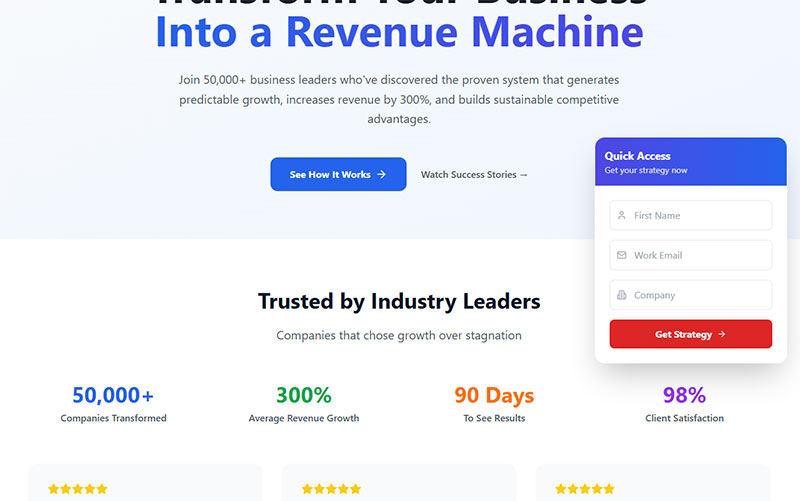
Exit-intent technology detects when users move cursors toward browser tabs or close buttons. Exit intent popup implementation rescues abandoning visitors with compelling offers. Timing matters critically here.
Time-based triggers activate after specific durations on pages. 30-60 seconds allows sufficient content consumption before form presentation. Shorter intervals annoy users. Longer delays miss conversion opportunities.
Scroll-based appearances trigger at predetermined page depths, typically 50-70% scroll completion. This approach targets engaged visitors while avoiding immediate interruption of browsing behavior.
Balancing user experience with lead capture goals requires careful consideration of frequency caps and visitor behavior patterns. Multiple popup presentations damage user experience and brand perception significantly.
Multi-Page Form Strategies
Breaking complex forms into digestible steps reduces psychological barriers to completion. Multi-step forms convert better than single-page equivalents when gathering extensive information.
Progress indicators show completion status and remaining effort required. Visual progress bars motivate continued engagement and reduce abandonment rates during lengthy processes.
Save and resume functionality accommodates interrupted sessions and complex decision-making processes. Business forms particularly benefit from this feature, allowing prospects to return after consulting colleagues or gathering required information.
Step conversion analysis reveals where users abandon multi-step processes. First-step completion rates typically exceed 80%. Subsequent steps show declining participation, highlighting optimization opportunities.
Copywriting and Messaging for Maximum Impact
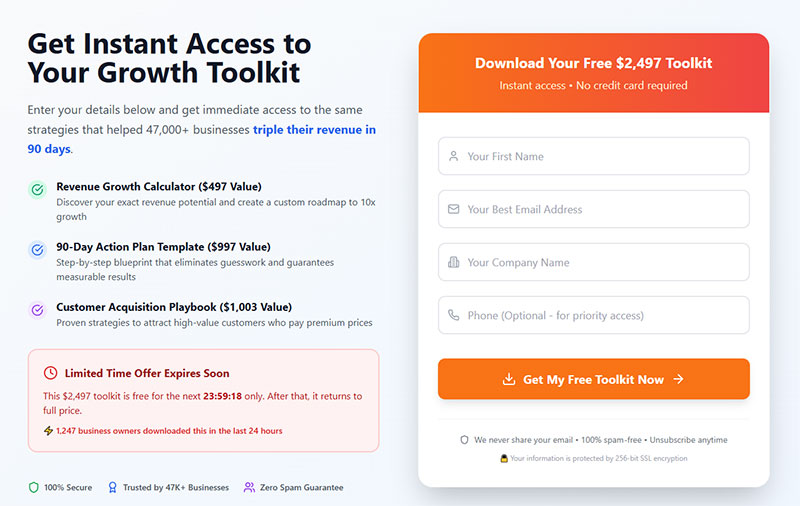
Value Proposition Communication
Clear benefit statements immediately communicate what users receive in exchange for personal information. “Download Your Free SEO Checklist” specifies tangible value. Generic “Subscribe Now” messaging fails to motivate action.
Benefit-focused language outperforms feature descriptions consistently. “Get Weekly Marketing Tips” resonates better than “Join Our Newsletter.” Users care about outcomes, not processes.
Social proof integration leverages existing customer satisfaction to encourage new submissions. “Join 10,000+ Marketers” or “Trusted by Fortune 500 Companies” builds credibility and reduces perceived risk.
Creating urgency without appearing manipulative requires authentic scarcity elements. Limited-time offers work when genuinely temporary. Fake countdown timers damage trust and brand reputation.
Call-to-Action Button Optimization
Action-oriented button text drives higher conversion rates than passive alternatives. “Get My Free Guide” outperforms “Submit” or “Continue.” First-person language creates psychological ownership.
Effective CTA examples include:
- “Start My Free Trial”
- “Download Now”
- “Get Instant Access”
- “Claim Your Spot”
- “Send Me Updates”
Button size and color testing reveals significant conversion variations. Orange buttons often outperform blue alternatives. Size increases up to optimal points before diminishing returns occur.
Multiple CTA approaches accommodate different user types and decision-making styles. Primary buttons drive main actions. Secondary options provide alternative paths without abandoning lead capture entirely.
Privacy and Trust Signal Integration
Privacy policy links and trust badges address growing data protection concerns. GDPR consent form examples demonstrate compliant approaches that maintain conversion rates.
Security assurances particularly matter for sensitive information collection. “We never share your email” or “100% spam-free” messaging reduces submission hesitation.
Spam protection messaging builds confidence in form submission processes. Explicit anti-spam commitments encourage participation from privacy-conscious prospects.
Company credibility indicators include:
- Industry certifications
- Customer logos
- Security badges
- Privacy compliance statements
- Money-back guarantees
Advanced copywriting techniques:
- Use power words that trigger emotional responses
- Match tone to target audience sophistication levels
- Test different value proposition angles
- Incorporate feedback forms learnings into messaging
- Apply sign up forms best practices across form types
Persuasive copywriting transforms functional forms into conversion-optimized lead generation tools. Focus on user benefits, remove friction through clear communication, and build trust through transparent value exchange.
Advanced Conversion Optimization Techniques
A/B Testing Form Elements
Setting up controlled experiments requires isolating single variables for accurate results. Test headline variations while keeping button colors constant. Change form length without altering placement. This methodical approach reveals true performance drivers.
Testing one element at a time prevents conflicting data. Multiple simultaneous changes make it impossible to identify which modification caused conversion improvements or declines.
Statistical significance demands adequate sample sizes before drawing conclusions. Rush decisions based on insufficient data lead to poor optimization choices. Most meaningful tests require 1,000+ form submissions per variation.
Common testing mistakes include:
- Stopping tests too early
- Testing multiple elements simultaneously
- Ignoring seasonal traffic variations
- Failing to segment different traffic sources
- Making changes based on personal preferences rather than data
Personalization and Dynamic Content
Using visitor data to customize forms dramatically improves conversion rates. Geographic targeting displays relevant contact information. Returning visitors see simplified forms with pre-populated fields.
Behavioral triggers activate specific form versions based on user actions. Blog readers encounter subscription forms with content-focused messaging. Product page visitors see sales-oriented capture forms.
Dynamic field population reduces user effort and increases completion rates. Known email addresses auto-fill when visitors return. Location-based services populate city and state fields automatically.
Personalization examples:
- Industry-specific value propositions
- Time zone-appropriate contact preferences
- Device-optimized form layouts
- Previous interaction-based messaging
- Purchase history-influenced offers
Integration with Marketing Automation
Connecting forms to email systems enables immediate follow-up sequences. Lead scoring algorithms evaluate submission quality based on provided information and engagement patterns.
Qualification workflows route high-value prospects to sales teams while nurturing lower-priority leads through automated sequences. WordPress lead generation plugins facilitate these integrations seamlessly.
CRM integration synchronizes lead data across marketing and sales platforms. This connectivity prevents duplicate entries and ensures consistent prospect communication.
Follow-up automation includes:
- Welcome email sequences
- Educational content delivery
- Product demonstration scheduling
- Sales team notification triggers
- Lead nurturing workflows
Common Mistakes and How to Avoid Them
Overcomplicating the Form Experience
Asking for excessive information upfront kills conversions. Lengthy forms intimidate visitors and increase abandonment rates significantly. Start with essential fields only.
Complex multi-step processes lose users between stages. Each additional step reduces completion by 10-20%. Simplify navigation and provide clear progress indicators.
Confusing layouts frustrate users and damage conversion performance. Unclear field labels, poor tab order, and inconsistent styling create friction. Form UX design principles prevent these issues.
Technical problems destroy user trust immediately. Broken submission processes, error-prone validation, and slow loading times drive prospects away permanently.
Weak Value Communication
Vague messaging fails to motivate action. “Sign up for updates” provides no compelling reason to share personal information. Specific benefits like “Get Weekly SEO Tips” perform dramatically better.
Missing benefit statements leave visitors guessing about value received. Clear exchange propositions improve conversion rates by 25-40%.
Inadequate trust signals especially hurt conversion in privacy-conscious markets. Missing privacy policies, unclear data usage statements, and absent security badges reduce form submissions.
Poor timing presents forms before establishing value or trust. Immediate popups annoy visitors. Context-appropriate placement performs significantly better.
Technical and Design Pitfalls
Slow loading affects conversion rates dramatically. Forms taking over 3 seconds to appear lose 40% of potential submissions. Optimize image sizes and minimize script dependencies.
Broken functionality creates instant abandonment. Form error message handling must work flawlessly across all scenarios.
Poor mobile implementation particularly damages performance as mobile traffic dominates most websites. Touch-friendly interfaces and proper responsive design are non-negotiable requirements.
Browser compatibility issues affect significant user segments. Internet Explorer, Safari, and mobile browsers handle forms differently. Comprehensive testing prevents costly oversights.
Prevention strategies:
- Use form validation to catch errors early
- Implement improving form abandonment rate techniques
- Apply web forms optimization methods
- Test conditional logic implementation thoroughly
- Monitor increasing form conversions metrics regularly
Successful optimization requires systematic testing, data-driven decisions, and continuous refinement based on user behavior patterns and conversion metrics.
Measuring Success and Continuous Improvement
Setting Up Proper Analytics and Tracking
Conversion tracking implementation forms the foundation of successful form optimization. Google Analytics 4 tracks form submissions as conversion events. Facebook Pixel captures lead data for advertising optimization. These tools provide essential performance insights.
Form abandonment analysis reveals where users drop off during completion processes. Hotjar and Crazy Egg show heatmaps highlighting problematic form areas. Users often abandon forms at specific fields, indicating optimization opportunities.
User behavior recording captures actual interaction patterns. Session replay tools demonstrate how visitors navigate forms. Mouse movement tracking reveals hesitation points and confusion areas.
Lead quality measurement systems evaluate submission value beyond quantity metrics. High-quality leads convert to customers at higher rates. Poor-quality submissions waste sales resources and inflate false success metrics.
Essential tracking metrics include:
- Form conversion rate percentage
- Field-by-field abandonment rates
- Time spent on form completion
- Mobile versus desktop performance
- Traffic source conversion variations
Regular Performance Review Process
Monthly conversion rate analysis identifies trends and seasonal patterns. Compare current performance against historical data. Look for sudden drops indicating technical issues or gradual declines suggesting optimization needs.
Lead quality assessment examines submission-to-customer conversion rates. Track which forms generate sales-ready prospects versus casual inquiries. Contact form submissions often show different quality patterns than lead generation form captures.
Cost per acquisition calculations determine form profitability. Include advertising spend, development costs, and staff time. Compare acquisition costs across different form types and placement strategies.
ROI measurement connects form performance to revenue generation. Calculate lifetime customer value from form-generated leads. This data guides optimization investment decisions and priority setting.
Review process checklist:
- Weekly conversion rate monitoring
- Monthly lead quality assessments
- Quarterly cost analysis updates
- Annual strategy reviews and adjustments
- Competitor form analysis comparisons
Iterative Improvement Strategies
Prioritizing changes based on potential impact prevents wasted optimization efforts. High-traffic forms with low conversion rates offer maximum improvement opportunities. Small conversion gains on popular forms generate significant results.
Creating testing schedules ensures systematic optimization approaches. Test one form element weekly. Run experiments for 2-4 weeks minimum. Document results before implementing additional changes.
Successful change documentation builds institutional knowledge and prevents repeated mistakes. Record test hypotheses, implementation details, and performance outcomes. This historical data guides future optimization decisions.
Scaling successful forms across channels multiplies optimization investments. Winning form designs work across multiple landing pages. Effective popup forms messaging applies to various campaign types.
Continuous improvement tactics:
- Implement conversational forms for engagement testing
- Test registration form templates against custom designs
- Monitor form submission confirmation message effectiveness
- Analyze survey form completion patterns
- Review intake form performance regularly
Advanced optimization approaches:
Machine learning algorithms predict optimal form presentation timing based on user behavior patterns. Predictive analytics identify high-value prospects before form submission. Dynamic content optimization automatically adjusts form elements based on performance data.
Cohort analysis tracks form performance across different user segments. Geographic targeting reveals regional conversion variations. Device-specific optimization addresses mobile and desktop performance gaps.
Cross-channel attribution connects form submissions to multiple touchpoints. Users often interact with brands multiple times before converting. Understanding these journeys improves form placement and messaging strategies.
Success measurement requires balancing quantity and quality metrics while maintaining focus on business objectives and long-term customer value generation.
FAQ on How To Design Lead Capture Forms
What’s the optimal number of fields for lead capture forms?
3-5 fields maximize conversion rates while capturing essential lead qualification data. Each additional field reduces completion rates by 10-15%. Start with name, email, and one qualifying question. Use progressive profiling to gather more information over time through follow-up interactions.
How do I increase form conversion rates?
Focus on clear value propositions, mobile optimization, and strategic placement. Test different headlines, button colors, and field arrangements. Reduce form friction by removing unnecessary fields and implementing real-time form validation to prevent errors.
Where should I place forms on my website?
Test above-the-fold versus below-the-fold positioning based on your content strategy. Sidebar forms work well for blogs. Landing page forms perform best when centered after value propositions. Avoid immediate popups that interrupt user experience.
What makes an effective call-to-action button?
Action-oriented text like “Get My Free Guide” outperforms generic “Submit” buttons. Use contrasting colors that stand out from your design. Test button sizes between 44-60px height for touch-friendly mobile interaction and optimal desktop visibility.
How do I optimize forms for mobile devices?
Use single-column layouts with touch-friendly 44px minimum field heights. Implement appropriate input types for better mobile keyboards. Mobile forms require larger buttons and adequate spacing to prevent accidental taps.
Should I use popup forms or inline forms?
Both work when implemented strategically. Exit intent popup captures abandoning visitors effectively. Inline forms feel less intrusive but may get overlooked. Test timing, frequency caps, and user behavior triggers for optimal results.
How do I write compelling form headlines?
Communicate specific benefits rather than generic requests. “Download Your SEO Checklist” outperforms “Subscribe to Newsletter.” Match tone to your target audience and include urgency elements like “Limited Time” when genuinely applicable.
What’s the best way to handle form errors?
Implement real-time validation with clear, helpful error messages. Highlight problematic fields with red borders and provide specific correction guidance. “Please enter a valid email address” works better than generic “Invalid input” messages.
How do I A/B test my forms effectively?
Test one element at a time for clear results. Compare headline variations, button colors, or field arrangements separately. Run tests for 2-4 weeks minimum with 1,000+ submissions per variation before drawing statistical conclusions.
What privacy elements should I include?
Add privacy policy links, spam protection messaging, and security badges to build trust. Include explicit consent checkboxes for GDPR compliant forms. Clear data usage statements reduce submission hesitation and improve conversion rates.
Conclusion
Mastering how to design lead capture forms transforms casual website visitors into qualified prospects. Successful conversion optimization requires balancing user experience with business objectives through strategic field selection, compelling copywriting, and seamless technical implementation.
Key success factors include mobile optimization, clear value propositions, and systematic A/B testing approaches. Form design excellence emerges from understanding user psychology and removing completion barriers.
Focus on these priorities:
- Minimize form friction through progressive profiling
- Test contact us page templates against custom designs
- Implement proper analytics for data-driven optimization
- Balance lead quantity with prospect quality metrics
Continuous improvement through regular performance analysis and iterative testing generates sustainable conversion rate improvements. Start with basic optimization principles, then advance to personalization and marketing automation integration.
Transform your customer acquisition strategy by applying these proven form optimization techniques consistently across all touchpoints.



